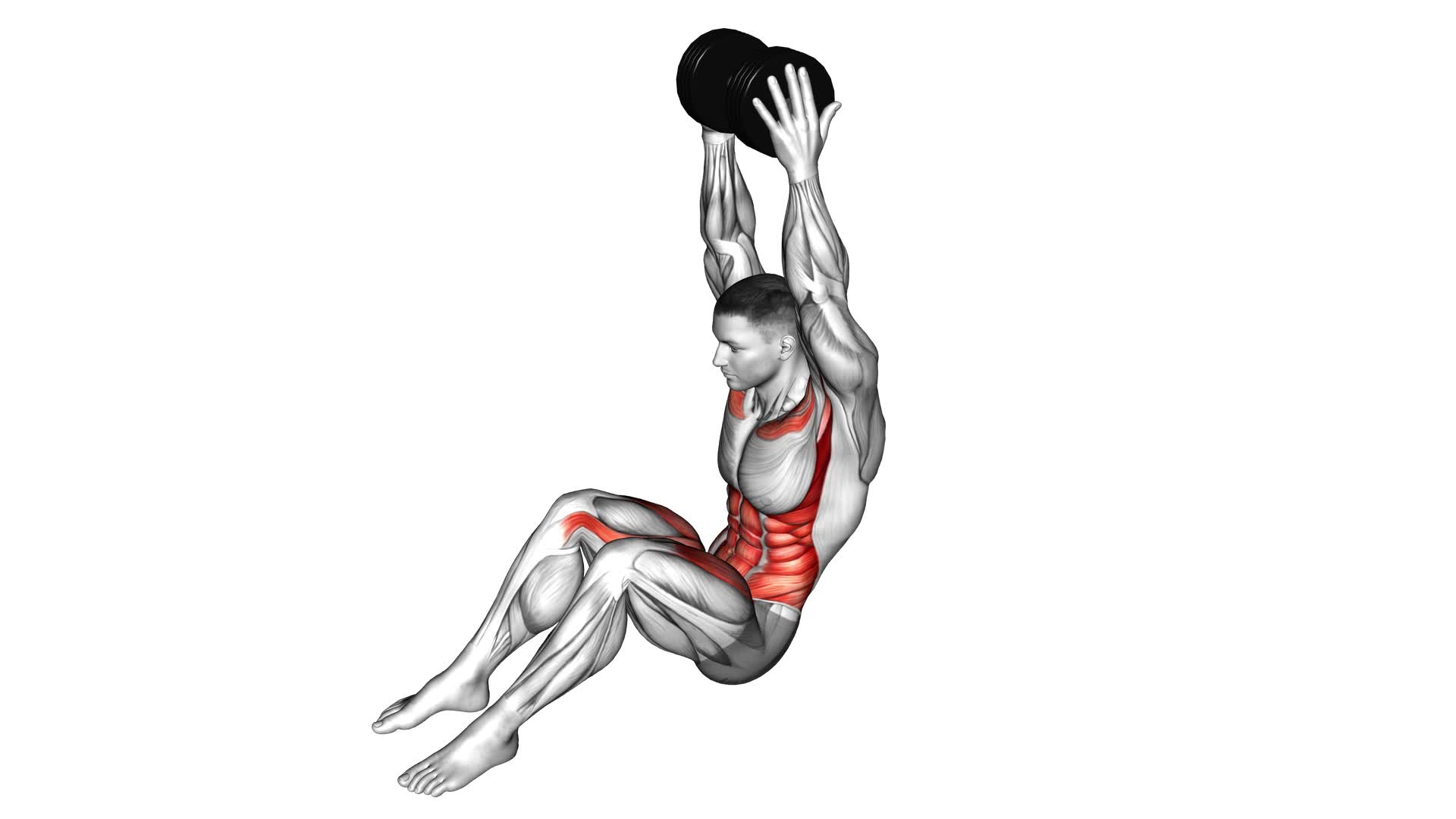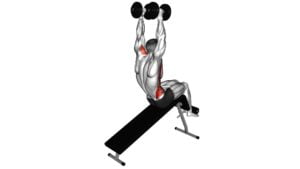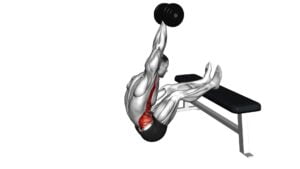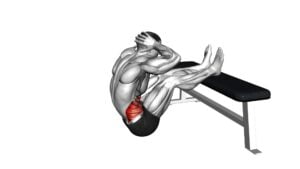Dumbbell Overhead Sit-up – Video Exercise Guide & Tips

Are you looking to strengthen your core and build strong abs?
Watch This Exercise Video
The dumbbell overhead sit-up is a fantastic exercise to add to your routine. By using a dumbbell and performing sit-ups with your arms extended overhead, you engage your entire core and increase the intensity of the exercise.
In this video exercise guide, you will learn the proper form, variations, and tips to maximize your results.
Get ready to feel the burn and see incredible results with the dumbbell overhead sit-up.
Key Takeaways
- The dumbbell overhead sit-up engages the entire core and increases the intensity of the exercise.
- It targets the rectus abdominis, obliques, and transverse abdominis, helping to strengthen and tone the midsection.
- Proper form and technique are essential, including keeping the back flat against the floor and exhaling as you sit up.
- Common mistakes to avoid include using too heavy of a dumbbell, rounding the back, and using momentum. Alternative exercises include regular sit-ups or Russian twists.
Benefits of the Dumbbell Overhead Sit-up
The dumbbell overhead sit-up offers a range of benefits for your core strength and stability. This exercise targets your abdominal muscles, specifically the rectus abdominis, obliques, and transverse abdominis, helping to strengthen and tone your midsection. By holding a dumbbell overhead during the sit-up, you increase the resistance and intensify the workout, further challenging your core muscles. This not only enhances your strength but also improves your overall stability and balance.
One of the key benefits of the dumbbell overhead sit-up is that it engages multiple muscle groups simultaneously. In addition to your core, this exercise also works your hip flexors, lower back, and shoulders. By incorporating these different muscle groups, you can develop a more functional core that supports your daily activities and improves your athletic performance.
Furthermore, the dumbbell overhead sit-up can be modified to suit your fitness level and goals. If you're a beginner, you can start by using a lighter dumbbell or no weight at all, gradually increasing the resistance as you get stronger. You can also try variations such as the bent-knee sit-up or Russian twist to target different areas of your core.
Equipment Needed for the Exercise
To perform the dumbbell overhead sit-up, you'll need a dumbbell and a mat for comfort. The dumbbell is an essential piece of exercise equipment for this particular exercise. It adds resistance and intensity to the sit-up, targeting your abdominal muscles more effectively. When choosing a dumbbell, select a weight that's challenging but manageable for you. Start with a lighter weight and gradually increase as you become stronger and more comfortable with the exercise.
The mat is another important piece of equipment needed for the dumbbell overhead sit-up. It provides cushioning and support for your back and tailbone, making the exercise more comfortable and preventing any discomfort or pain. Look for a thick and non-slip mat that will provide adequate padding and stability during the exercise.
In addition to the dumbbell and mat, it's also recommended to have a stable surface to perform the exercise on. A gym floor or a flat surface at home would work well. Make sure the area is clear of any obstacles or hazards to ensure your safety while exercising.
With the proper equipment, you can perform the dumbbell overhead sit-up effectively and safely, targeting your abdominal muscles and achieving your fitness goals.
Proper Form and Technique for the Dumbbell Overhead Sit-Up
How can you ensure proper form and technique when performing the dumbbell overhead sit-up?
To begin, make sure you have a dumbbell that's appropriate for your strength level. Holding the dumbbell with both hands, extend your arms straight above your head. As you perform the sit-up, keep your back flat against the floor and engage your core muscles. Avoid using momentum to lift your upper body; instead, focus on using your abdominal muscles to control the movement. It's important to exhale as you sit up and inhale as you lower yourself back down.
Now let's talk about some common mistakes to avoid.
One mistake is using too heavy of a dumbbell, which can lead to strain on your neck and back. Another mistake is rounding your back or using your arms to pull yourself up, which takes the focus away from your abs. To ensure proper form, it's helpful to have a spotter or trainer observe your technique and provide feedback.
If you find the dumbbell overhead sit-up to be too challenging or uncomfortable, there are alternative exercises you can try.
One option is to perform regular sit-ups without the dumbbell overhead. Another alternative is the Russian twist, which targets your obliques. Remember to always listen to your body and modify the exercise as needed to avoid injury.
Now that you know how to perform the dumbbell overhead sit-up with proper form and technique, let's explore some variations and modifications to try in the next section.
Variations and Modifications to Try
Try incorporating different variations and modifications to challenge yourself during the dumbbell overhead sit-up. One variation you can try is using different types of dumbbells. Instead of using standard dumbbells, you can use kettlebells, medicine balls, or even resistance bands. These alternative options can provide a different level of resistance and engage your muscles in unique ways.
When choosing which type of dumbbell to use, consider your fitness level and goals. If you're a beginner, start with lighter dumbbells and gradually increase the weight as you become stronger and more comfortable with the exercise. On the other hand, if you're more advanced, you can opt for heavier dumbbells to intensify the workout.
It's important to be mindful of common mistakes to avoid during the dumbbell overhead sit-up. One common mistake is using your neck and shoulders to lift yourself up instead of engaging your abdominal muscles. To prevent this, focus on keeping your core tight and your gaze forward throughout the movement.
Another mistake to avoid is arching your back excessively. This can put strain on your lower back and lead to discomfort or injury. To maintain proper form, keep your back flat against the floor and engage your core muscles to lift yourself up.
Tips for Maximizing Your Results With the Dumbbell Overhead Sit-Up
Maximize your results with the dumbbell overhead sit-up by incorporating these effective tips.
To ensure you get the most out of this exercise, it's important to avoid common mistakes and choose the right weight.
One common mistake people make when performing the dumbbell overhead sit-up is using too much momentum. Remember to engage your core and use controlled movements throughout the exercise. This will help to target your abdominal muscles more effectively and prevent strain on your lower back.
Another mistake to avoid is using a weight that's too heavy or too light. The recommended weight for the dumbbell overhead sit-up is one that challenges you without compromising your form. Start with a weight that allows you to complete 8-12 reps with proper technique. As you become stronger, you can gradually increase the weight to continue challenging your muscles.
It's also important to maintain proper form throughout the exercise. Keep your feet flat on the ground, knees bent, and your back in a neutral position. As you perform the sit-up, focus on lifting your torso towards the ceiling while keeping the dumbbell overhead. This will engage your abs and help to strengthen your core.
Frequently Asked Questions
How Many Reps and Sets Should I Do for the Dumbbell Overhead Sit-Up?
To determine the number of reps and sets for the dumbbell overhead sit-up, consider your fitness level and goals. Start with 2-3 sets of 10-12 reps and gradually increase as you get stronger.
Maintaining proper form is crucial for this exercise.
Benefits of incorporating the dumbbell overhead sit-up into your routine include strengthening your core, improving stability, and increasing upper body strength.
Remember to consult with a fitness professional for personalized guidance.
Can I Perform the Dumbbell Overhead Sit-Up if I Have Lower Back Pain?
If you're experiencing lower back pain, it may not be ideal to perform the dumbbell overhead sit-up. However, there are alternatives you can try that may be more suitable for you. It's important to listen to your body and avoid any exercises that exacerbate your pain.
Instead, focus on exercises that strengthen your core without putting strain on your lower back. Discuss with a fitness professional to find the best options for you.
Is It Necessary to Use a Dumbbell for the Overhead Sit-Up, or Can I Use a Different Type of Weight?
You don't necessarily have to use a dumbbell for the overhead sit-up. There are different types of weights you can use instead.
However, using a dumbbell has its benefits. It adds resistance to the exercise, making it more challenging and effective in strengthening your core muscles. The weight also helps in engaging your upper body and improving stability.
Can I Incorporate the Dumbbell Overhead Sit-Up Into My Ab Workout Routine?
Yes, you can definitely incorporate the dumbbell overhead sit-up into your ab workout routine. It's a great way to challenge your core muscles and improve your strength.
By adding the dumbbell, you increase the resistance and make the exercise more effective. The benefits of the dumbbell overhead sit-up for core strength include better stability, increased muscle activation, and improved overall abdominal strength.
How Long Should I Rest Between Sets of the Dumbbell Overhead Sit-Up?
When it comes to resting between sets of the dumbbell overhead sit-up, it's important to find the right balance. Resting too little may lead to fatigue and decreased performance, while resting too long may not challenge your muscles enough.
A good starting point is to rest for about 30-60 seconds between sets. However, as you progress and become more advanced, you can decrease the rest time to 15-30 seconds to increase the intensity and challenge your abdominal muscles even more.
Conclusion
In conclusion, the dumbbell overhead sit-up is a highly effective exercise that targets the core muscles and enhances overall strength. By incorporating this exercise into your workout routine, you can improve your posture, stability, and abdominal strength.
Remember to maintain proper form and technique, and consider trying variations or modifications to challenge yourself further. By following these tips, you can maximize your results and achieve a stronger and more toned midsection.

Author
Years ago, the spark of my life’s passion ignited in my mind the moment I stepped into the local gym for the first time. The inaugural bead of perspiration, the initial endeavor, the very first surge of endorphins, and a sense of pride that washed over me post-workout marked the beginning of my deep-seated interest in strength sports, fitness, and sports nutrition. This very curiosity blossomed rapidly into a profound fascination, propelling me to earn a Master’s degree in Physical Education from the Academy of Physical Education in Krakow, followed by a Sports Manager diploma from the Jagiellonian University. My journey of growth led me to gain more specialized qualifications, such as being a certified personal trainer with a focus on sports dietetics, a lifeguard, and an instructor for wellness and corrective gymnastics. Theoretical knowledge paired seamlessly with practical experience, reinforcing my belief that the transformation of individuals under my guidance was also a reflection of my personal growth. This belief holds true even today. Each day, I strive to push the boundaries and explore new realms. These realms gently elevate me to greater heights. The unique combination of passion for my field and the continuous quest for growth fuels my drive to break new ground.







